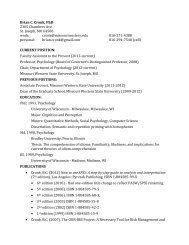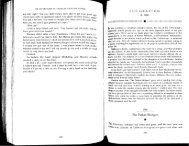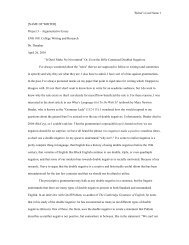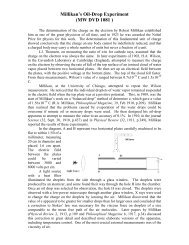Welcome to Your World, Baby
Welcome to Your World, Baby
Welcome to Your World, Baby
You also want an ePaper? Increase the reach of your titles
YUMPU automatically turns print PDFs into web optimized ePapers that Google loves.
It is perhaps fitting <strong>to</strong> begin achapter on gender and languagewith an analysis ofbaby cards. If you've evershopped for a baby card. youmay have noticed that thebaby's gender is an importantfeature; almost all such cardsare gender-specific. This reportwas originally publishedin the academic journalWomen and Language inApril 2001. The author. LyndaR. Willer. researches genderand organizational communicationat Purdue UniversityCalumet. Willer presents herea detailed. scholarly analysisof the content of 300 cards.LYNDA R. WILLER<strong>Welcome</strong> <strong>to</strong> <strong>Your</strong> <strong>World</strong>,<strong>Baby</strong>INTRODUCTION"Congratulations on your new bundle of joy." "<strong>Welcome</strong><strong>to</strong> the bouncing baby boy." "<strong>Welcome</strong> <strong>to</strong> the sweet angelicbaby girl." A friend has just had a baby and you want <strong>to</strong>send a greeting card acknowledging the event. As you examinecard after card at the local greeting card s<strong>to</strong>re, yourealize you need <strong>to</strong> negotiate the greeting card industry'ssocial construction of gender. Amid pinks and blues, sugar& spice and snakes & snails, and angelic behaviorand roughhousing, a definite message of what having agirl baby means and what having a boy baby means isbeing delivered (whether you want <strong>to</strong> support that messageor not). A question can be raised concerning the impac<strong>to</strong>f these greeting card messages on the fostering andperpetuating of sex role identities.THE GREETING CARD INDUSTRYAND GREETING CARDSAS MESSAGE COMMUNICATORSThe greeting card industry is an industry worth more thanseven billion dollars a year. Additionally, over 90 percen<strong>to</strong>f the consumers of greeting cards are women. As a result,greeting cards have great communication potentiaLparticularly for women and about issues related <strong>to</strong> gender.As a form of mass communication, greeting cards areused [primarily by women] <strong>to</strong> "maintain, reinforce and reestablishsociaL particularly familial, relationships."* * *SEX ROLEOne of thebaby is amannouncerrChildren afriends. Mldaughtershave diffesition. Thubeen annOlfirst annOl(p.209).We meacknowledwith the rrsages, mesiors are se:The asceive mesAdults bofcate differcommunicldifferencegreeting c(system...guage ane'boy' and 'IWilberfemale bothrough thsweet arelikely <strong>to</strong> bthe langU
Lynda R Willer: <strong>Welcome</strong> <strong>to</strong> <strong>Your</strong> <strong>World</strong>, <strong>Baby</strong> 0 337SEX ROLE IDENTITYelcomemgelic/'Iant <strong>to</strong>you exre,youustry'ses, suhaviorving a~ans ist mesheimgandthanrcenta remtial,) genS arend re-One of the first questions asked by family and friends upon the arrival of ababy is answered by the message "it's a boy" or "it's a girl." With that simpleannouncement begins a process of socialization in<strong>to</strong> a "gendered" world.Children are influenced through the socialization processes of family andfriends. Mothers and fathers frequently have different expectations fordaughters and sons. They communicate differently in the family and theyhave different ways in which they are responsible for sex role acquisition.Thus, as Bate and Bowker (997) explain, "Once a baby's sex hasbeen announced, other messages will be sent and received that concern thatfirst announcement of biological sex in<strong>to</strong> gender-related expectations"(p.209).We make these announcements through birth announcements and weacknowledge this announcement with a congratula<strong>to</strong>ry greeting card. Andwith the message of "it's a boy/girL" and subsequent congratula<strong>to</strong>ry messages,messages of perceptions of gender and "appropriate" sex role behaviorsare sent.The assignment of sex roles can begin with birth as adults send and re- 5ceive messages about the attributes they perceive the infant possesses.Adults both perceive they should, and in many cases actually do, communicatedifferently with children depending on the gender of the child. Thatcommunication difference may start earlier than believed as we foster thedifference through communication expressed in the birth congratulationgreeting card. "Gender symbols and expectations emerge early in the familysystem.... The baby as <strong>to</strong>pic of conversation receives a large amount of languageand nonverbal behavior based on others' connotations for the labels'boy' and 'girl''' (Bate & Bowker, 1997, p. 218).Williams and Best (982) propose that from birth it is clear that male andfemale babies are treated differently. This difference can be illustratedthrough the use of language <strong>to</strong> describe babies. Words such as loving, cute,sweet are often used <strong>to</strong> describe female babies while male infants are morelikely <strong>to</strong> be described with words such as strong, solid, independent. Thus,the language used in birth congratulation cards can be examined <strong>to</strong> illustratethe reflection of these perceived gender differences. As a result, the followingresearch question is raised:Research Question 1: What are the differences in language usage in boyspecifiedbirth congratulation greeting cards, girl-specified birth congratulationgreeting cards, and no gender-specified birth congratulation greetingcards?
nI...-338 0 Chapter 6: His and HersIDifferences between male and female infants are also communicatednonverbally,The ritual of assigning gender-specific colors of pink and blue helpsperpetuate the gender identity issue of difference. Further, when theobjects/symbols are attached <strong>to</strong> either male babies or female babies, supportfor sex role differences is communicated-from the pink cap given <strong>to</strong> girl babiesin a hospital <strong>to</strong> the way the baby's room is decorated, <strong>to</strong> the way thebaby is clothed, <strong>to</strong> the <strong>to</strong>ys selected for play. Thus, birth congratulation cardscan be examined for the nonverbal messages that are sent that may perpetuateperceived gender differences. As a result, a second research questioncan be asked:Research Question 2: What are the differences in nonverbal communica- 10tion usage in boy-specified birth congratulation greeting cards, girl-specifiedbirth congratulation greeting cards, and non gender-specified birth congratulationgreeting cards?METHODTHE CARDSThree hundred "<strong>Welcome</strong> <strong>Baby</strong>" greeting cards were examined. A conveniencesample l was collected by visiting ten card s<strong>to</strong>res and choosing 10 boyidentifiedcards, 10 girl-identified cards and 10 non-gender-specific cards ateach s<strong>to</strong>re. The manufacturers of each card were identified and a manipulationcheck was performed <strong>to</strong> make sure a variety of manufacturers were represented.The following greeting card manufacturers were identified:Carl<strong>to</strong>n (20,22,17), Simply Said: Bjorkman Brothers 0,0,0), Gibson (20,17,17).Forget Me Not (6,8,17), Mahogany (3,0,10), Hallmark (26,20,8), Ambassador05,21.6), Card Fac<strong>to</strong>ry Outlet (8,6,22), Life as We Know It (O,Ll), Creative Papers(0,5,0) and Kinka (0,0,3). The numbers in parentheses represent the numberof boy-identified cards, girl-identified cards and non-gender specificcards, respectively. Carl<strong>to</strong>n and Hallmark account for 70 percent of the greetingcard market (Sheikh, 1999). This selection represents a cross-section ofgreeting card manufacturers who s<strong>to</strong>ck retail greeting card s<strong>to</strong>res as well asother retailers who sell greeting cards; from Hallmark the manufacturer withthe largest share of the greeting card market <strong>to</strong> the small, specialty manu-I, convenience sample one ,hal is easily available, in contrao' ',0 a random sample, whereevery card 'Ni:h:" (l category has an equal chance of being chosen,facturepolitanTHE CAThe cawelconhundrehas faiIncludihighligand ca:EmoutsidEcategolidentifiitems vlated. :humorcidentifiwas arwhat egenderIn Icolors IAdditieof <strong>to</strong>ys,and cllBridge~did no'Bridge!of theslRESULIn gen.expectand be
Lynda R. Willer: <strong>Welcome</strong> /0 <strong>Your</strong> <strong>World</strong>, <strong>Baby</strong> 0 339icatedfacturers. All cards were available in s<strong>to</strong>res located in a midwestern metropolitan area.helpsn thelpportirl baythecardspetustionnicafied9ratvenboydsatpula~ repified:7,17),adorPa-Ufficificreetnofaswithanu-~ll,,here10THE CATEGORIESThe cards were categorized first based on gender specification. Did the cardwelcome a baby boy, a baby girl or was the card non-gender-specific? Onehundred cards in each of these categories were identified. Previous researchhas failed <strong>to</strong> use the non-gender-specified card as an informal control group.Including the non-gender-specified cards in this analysis will presumablyhighlight the anticipated differences between cards intended for girl babiesand cards intended for boy babies.Each card was examined for its outside greeting, its inside greeting, itsoutside colors and symbols, and its inside colors and symbols. Within thesecategories, more specific categories were created utilizing a coding schemeidentified by Bridges (1993). For the outside and inside greetings, severalitems were examined. The number of words used in the greeting was calculated.The quality of the message was assessed (was the message serious,humorous or offer nothing but congratulations). The style of the message wasidentified (was the verse in rhyme or prose). And the specific word choicewas analyzed for whether it was a physical or nonphysical descrip<strong>to</strong>r, forwhat emotion or experience the word/phrase represented and for whether agender-specific interest was identified.In examining the nonverbal message sent via these greeting cards, thecolors represented both on the front and inside of the card were identified.Additionally, what the pictures represented were separated in<strong>to</strong> categoriesof <strong>to</strong>ys, animals and objects (such as baby items, hearts, flowers, moon, starsand clothing) and what type of scene (active or passive) was depicted.Bridges' (1993) work in this area did not examine this quantity of cards anddid not use non-gender-specific cards as a comparison baseline. Further,Bridges' focus was on the psychological versus the communicative functionof these messages.RESULTSIn general. the results might be identified as what one might. unfortunately, 15expect. In many instances there are differences between girl-identified cardsand boy-identified cards. This paper establishes a 10 percent frequency dif
340 0 Chapter 6: His and Hersference as a difference that had some meaning. At the same time, other resultsnot meeting those criteria but providing interesting or unexpected informationare also provided. The discussion will primarily focus on thedifferences between boy/girl-identified cards, utilizing the non-genderspecifiedcards as an informal control group <strong>to</strong> highlight some of the verbaland nonverbal issues being raised.RESEARCH QUESTION #1Research question #1 dealt with the verbal characteristics of greeting cardsand how gender differences might be illustrated. The general categories ofoutside (front) of card text, and inside card text were identified. The cardswere analyzed by looking at the number of words, the style of the message,the message quality, physical/nonphysical word descriptions of the baby, andwords used <strong>to</strong> express emotion and experiences about the birth of a child.Number of Words. Message Style and Message Quality. All three main typesof birth congratulation cards contained similar numbers of words. Girl cardsaveraged 38.3 words, boy cards averaged 37.1 words and non-genderspecifiedcards averaged 31 words. The messages of non-gender-specifiedcards were more likely (68%) than both girl (56%) and boy (38%) cards <strong>to</strong> be ina prose style. Additionally, the messages of girl cards were more likely thanboy cards <strong>to</strong> be in prose style. Boy cards were more likely <strong>to</strong> be in rhymeinstead of prose and more likely <strong>to</strong> be in rhyme than both girl and nongender-specifiedcards. Boy was rhymed frequently with "joy" or son with"fun" while the only rhyme matched with the word "girl" was "whirl" and"twirl." At least 80 percent of each of the types of cards was likely <strong>to</strong> have amessage that was serious rather than funny or one that just provided congratulations.Word Descrip<strong>to</strong>rs. The analysis also looked at specific word usage concerningdescriptions of the baby. One category of words concerned physical characteristicsof the baby. The words "little," "tiny" or "small" appeared morefrequently in girl cards (46%) or non-gender-specified cards (45%) than boycards (34%). Furthermore, "tiny" and "small" were only used <strong>to</strong> describe girlbabies or a non-gender-specified baby. Girl babies were also more likely <strong>to</strong>be described as "cute" or "beautiful" than boys or the non-gender-specifiedbaby. However, this difference did not meet the 10% difference criterion. Althoughthere was a wide variety of words used <strong>to</strong> describe non-physicalcharaeteri~cious" aneas "sweet"specified 1"precious"Although 1words thatnot girls. Ewere: "de"soft," andgirl babie!"noisy," "blikely <strong>to</strong>"scamp," "Emotions/lexaminedjoy (21%) .(29%), joy(boy baby
Lynda R. Willer: <strong>Welcome</strong> (0 <strong>Your</strong> <strong>World</strong>, <strong>Baby</strong> 0 341characteristics of a baby, three were used most frequently: "sweet," "precious" and "dear." Girl babies were much more likely <strong>to</strong> be describedas "sweet" (27%) or "precious/dear" (29%) than boy babies. The non-genderspecified babies approached a similarity with girl babies with the words"precious" or "dear" and similarity with boy babies with the word "sweet."Although not providing a statistical difference, it is interesting <strong>to</strong> look atwords that were used <strong>to</strong> describe girls but not boys and <strong>to</strong> describe boys butnot girls. Examples of words used <strong>to</strong> describe girl babies but not boy babieswere: "delicate," "irresistible," "trusting," "gentle," "warm," "innocent,""soft," and "giggly." Examples of words used <strong>to</strong> describe boy babies but notgirl babies were: "bold," "brave," "<strong>to</strong>ugh," "important," "busy," "alarming,""noisy," "bright," "healthy" and "fine." Further, boy babies were much morelikely <strong>to</strong> have active words describing them such as "doer," "rascal.""scamp," "crawler," "grower," "teaser," "walker," "player" and "talker,"reinther)alrdsofrdsge,ndEmotions/Experiences. The content of the messages of the cards was also)esexamined for what emotions or experiences were presented. Love (40%) and~dsjoy (21 %) were the most expressed emotions in the girl baby cards. Loveer(29%). joy (47%) and happiness (29%) were the most expressed emotions in theledboy baby cards. And yet, love was more frequently expressed concerning girl, in babies and joy and happiness were more frequently expressed regardinganboy babies, Thus, there was a difference between the girl baby and boy babymecards on these expressions of emotions. Other emotions expressed concern)ning girls were fun/laughter and happiness, while pride and fun/laughterith were also expressed about boys. Love (34%), happiness (30%), and joy (22%)ndwere also the predominant emotions expressed in the non-gender-specified~ a cards. Also interesting was the difference between non-gender-specifiedcards and boy and girl cards regarding the expression of being blessed (13%<strong>to</strong> 3% and 4% for girl cards and boy cards, respectively), This implies that themore religious birth congratulation cards may more frequently not be gendern specific.r An additional analysis looked at terms that seemed <strong>to</strong> present a gender 20respecific interest. Although not significant, there were birth congratulationoycards for girls that identified a girl as a shopper. as a phone talker, as clothirling conscious, as an enchanting spell binder, as a secret keeper, as a heart<strong>to</strong>and scene stealer, as needing security, as "daddy's prize." Additionally, theredwere birth congratulation cards for boys that identified a boy as a cham\.1 pion, as a prince, as a blue dresser, as an explorer, as first class male, as aalskipper/mate, as someone who would change the world, as a main event.
342 0 Chapter 6: His and HersRESEARCH QUESTION #2Research question #2 dealt with the nonverbal aspects of birth congratulationgreeting cards. In order <strong>to</strong> accomplish this analysis the cards were eachexamined for the images they presented through pictures and symbols andfor the color usage on the cards.picturedcards is15%). Bemoons, ~bottles,bined,llikely tcfrequToys. The <strong>to</strong>ys pictured on the cards were identified. The single most In trepresented <strong>to</strong>y for both girls and boys and in non-gender-specified cardsgirl canwas blocks. However, the <strong>to</strong>y appeared more frequently in cards about boysboy car(29%) than cards about girls (14%). All three types of cards pictured balls on only onthe cards without meaningful difference. However, if you combine <strong>to</strong>y ballsever, Wwith sporting balls and other sporting equipment such as mitts, bats and helunifommets, there was a meaningful difference between what is shown on boysuch aIcards (42%) and girl cards (14%) and non-gender-specified cards (6%). In fact.cards for girl babies and cards that had no gender specification had no otherScenestypes of balls or other sporting equipment."activeThe item pictured second most on boy cards was a boat (24%). Both girlcrawliland non-gender-specified cards had only one card each with a picture of abeing]boat. And if you add <strong>to</strong> boats other <strong>to</strong>ys that represent forms of transportationonemisuch as trains, planes, cars, trucks and wagons, the frequency of pictures inin 51 pcreased immensely for boy cards <strong>to</strong> sixty-eight. while the girl cards and theand ncnon-gender-specified cards only increased from 1 percent each <strong>to</strong> 2 and 3 pernon-gecent. respectively.in 49 pOne of the surprising results came from the unmet expectations aboutcent apictures of dolls. While certainly more girl cards than boy cards (or non-genboy ccder-specified cards) had a picture of a dolL only 11 percent of the cardsincluded a picture of. a doll (boy cards and nongendet specified cards conColor!tained only one picture of a doll each).identicolor lAnimals. Bears (both Teddy bears and real bears) were the most frequently 25the mrepresented animal on all three types of cards. In fact, there were no frepeete lquency differences among the cards in the three most pictured animals:Girl cbears, rabbits and ducks.spedObjects. There were several differences specifically between the boy cards boy cand the girl cards identified concerning visual representation of specific obgirl ejects. For example, three times as many girl cards (30%) as boy cards (9%) andquentwo times as many girl cards as non-gender-specified cards 05%) had heartscard!
Lynda R. Willer: <strong>Welcome</strong> <strong>to</strong> <strong>Your</strong> <strong>World</strong>, <strong>Baby</strong> 0 343ngratularereeach.bols andlIe mostedcardslout boysballs on<strong>to</strong>y ballsand helIon boyl. In fact.no other30th girl:ure of a.ortationlures inandtheld 3 per.s abou<strong>to</strong>n-genecardsds conuently25no freimals:y cardsific ob%) andheartspictured on the cards. A similar comparison between girl cards and boycards is true as well for pictures of flowers (27% <strong>to</strong> 1%) and rattles (27% <strong>to</strong>15%). Boy cards were more likely <strong>to</strong> have pictures of sky items (clouds,moons, stars, suns) than girl cards (25% <strong>to</strong> 15%). If baby-related items such asbottles, bibs, pins, mobiles, pacifiers, blankets/quilts, and rattles are combined,both girl cards (64%) and non-gender-specified cards (69%) are morelikely <strong>to</strong> have such items pictured than boy cards (49%).In the clothing department. dresses were more likely <strong>to</strong> be pictured ongirl cards (11 %) than on boy cards (0) as were bows (21 % on girl cards and noboy cards had a bow). Similarly, nine cards for girls had lace on them whileonly one boy card and one non-gender-specified card had lace on them. However,when it came <strong>to</strong> a specific outfit such as a cowboy outfit. a sailor suit, auniform, overalls, a ballet costume, boy cards (18%) were more likely <strong>to</strong> havesuch an outfit pictured than girl cards (7%).Scenes. The scene pictured on the card was also interpreted as either being"active" (the baby was doing something on his/her own such as walking orcrawling) or "passive" (the baby was seen as sleeping, sitting in his/her crib,being held, etc.). Given gender stereotype and sex role identity research, asone might expect. on boy cards babies were pictured doing something activein 51 percent of the cards compared <strong>to</strong> 18 percent and 16 percent on girl cardsand non-gender-specified cards, respectively). Conversely, on girl cards andnon-gender-specified cards, babies were pictured doing something passivein 49 percent and 43 percent of the cards, respectively, as compared <strong>to</strong> 23 percen<strong>to</strong>f the cards where a baby was pictured doing something passive on aboy card.Colors. Finally, the colors used on the cards were identified. Colors wereidentified on the front (outside) of the cards, on the inside of the card and forcolor of the writing on the inside of the card (where frequently the majority ofthe message is). The results of this analysis are what might typically be expected.Boy cards utilized dark blue (77%) and yellow (74%) most frequently.Girl cards utilized pink (92%) and yellow (40%) most frequently. non-genderspecifiedcards used yellow (68%), red (51%), and light blue (50%) mostfrequently. On the inside of the cards, dark blue is used more frequently onboy cards (34 <strong>to</strong> 0 when compared with girl cards) with pink being used ongirl cards (34 <strong>to</strong> 2 when compared <strong>to</strong> boy cards). Black was the most frequentlyused color for the writing on all types of cards although 32% of boycards also used dark blue for the writing.
344 0 Chapter 6: His and HersDISCUSSIONThis paper presents the results of a content analysis of birth congratulations 30greeting cards. It is argued that greeting cards represent a means of sendingintentional or unintentional messages about gender roles. This study sought<strong>to</strong> examine messages of gender expectations in birth congratulation cards.Three hundred cards were analyzed of which 100 each were cards designatedfor boy babies, cards designated for girl babies and cards not designatedfor either gender. The results suggest that "gendered" messages arebeing sent and are consistent with previous research in sex role identity andsocialization. Further, the results are consistent with past research on thecommunicative value of greeting card messages. In spite of (or perhaps becauseof) living in the '90's, the same stereotypical messages about genderare being sent and received as have been perceived in the past. The messageof expected differences between boys and girls is communicated. Additionally,the message of appropriate behaviors for each of the sexes is communicated.Thus, the greeting card industry reflects (or perhaps infects) society'sperceptions of what girl babies are and what boy babies are and whatthey do depending on their gender. And while the babies are not doing theactual receiving of the message, they are going <strong>to</strong> be the recipients of theseperpetuated gender expectations via family, friends and the massmedia.Language usage organizes our perceptions of gender. Further, we canexamine language usage <strong>to</strong> evaluate these gendered messages. And so inthis study, we see differences in the message style of birth congratulationcards, differences in words used <strong>to</strong> describe physical characteristics of boybabies and girl babies, as well as differences in words used <strong>to</strong> describe nonphysicaldifferences. Further, there are some differences in the emotions expressedabout girl babies and boy babies.Previous research has indicated ways in which we can communicategender differences nonverbally through, for example, color usage and the attachmen<strong>to</strong>f specific symbols or objects only <strong>to</strong> girls or only <strong>to</strong> boys. Thus,nonverbal differences are also identified in the current study. There are differencesin the type of <strong>to</strong>ys pictured as well as some of the objects identifiedsuch as hearts, flowers and baby-related items. Additionally, what babiesare observed doing, in cards that portray such behavior, appears <strong>to</strong> be differentdepending upon whether it is a girl card or a boy card since girls are observedas being more passive and boys as being more active. In fact, boysare frequently seen doing things (playing sports) or playing with <strong>to</strong>ys (elaboratetrain sets) that are inappropriate for a newborn child. Babies on girlcards andhaviors SIcolors USEbased onAs w:study as \large nun<strong>to</strong> create (per categ,ponies ut:beyond tl:A secmay be tparts of tlFurthamined. (tive rand,out the rEstudied tlthe resultwanting Ither a reIcome littlThis!sages. Thexpectati,tions at pcard thatwhat oneone sensimessage!issues neall else f,cards an,trapping,REFERENCBate, B., 8WaVE
Lynda R. Willer: <strong>Welcome</strong> <strong>to</strong> <strong>Your</strong> <strong>World</strong>. <strong>Baby</strong> 0 345tulations 30IsendingIy sought)n cards.Is desigotdesig::tges are:ltityandh on thenaps betgender'he mes[ted. Ad:; is com:ts) socindwhat:>ing theof these, masswe canld so intulation; of boybe nononsexnicatethe at. Thus.:tre diftifiedbabiesdifferreobI, boys~elabo>n girlcards and non-gender-specified cards seem <strong>to</strong> be doing age-appropriate behaviorssuch as sleeping in a crib and being held by an adult. Finally, thecolors used on the cards appear <strong>to</strong> further delineate the pink-blue dicho<strong>to</strong>mybased on gender.As with many research projects. limitations can be identified in thisstudy as well. The sample selection was a convenience sample. And while alarge number of cards were selected and several card companies were used<strong>to</strong> create a cross-section of examples and <strong>to</strong> identify a minimum of 100 cardsper category, this sample did not mirror the market shares of the card companiesutilized. Thus. caution should be used when attempting <strong>to</strong> generalizebeyond the sample studied.A second limitation may be the geographical usage of the Midwest. Itmay be possible that card selection and availability is different in otherparts of the country and in different types of s<strong>to</strong>res selling greeting cards.Further research is needed in this area. Several issues remain <strong>to</strong> be ex- 35amined. Obviously. the current study could be replicated with a representativerandom sample. Another intriguing area of research would be <strong>to</strong> fleshout the results of the non-gender-specified cards. In many of the categoriesstudied the results relating <strong>to</strong> the non-gender-specified cards were similar <strong>to</strong>the results of the girl cards. It is interesting <strong>to</strong> contemplate that those buyerswanting not <strong>to</strong> send a gendered message are actually forced in<strong>to</strong> sending eithera religious message or one that approximates the message sent <strong>to</strong> welcomelittle girls.This study implies that greeting cards are another source of gender messages.They continue <strong>to</strong> communicate stereotypical messages about genderexpectations. The limited choices for card buyers suggest societal expectationsat play in the market research. The selection of a gender-free card. or acard that identifies biological gender without stereotypical trappings aboutwhat one gender or the other is or should be, becomes a challenge for anyonesensitive <strong>to</strong> the impact of continuing <strong>to</strong> communicate these "gendered"messages. And when lack of choice prevails. those of us concerned with suchissues need <strong>to</strong> voice these concerns <strong>to</strong> greeting card companies. And whenall else fails, with greeting card software available, we can make our owncards and welcome these babies in<strong>to</strong> the world without the stereotypicaltrappings of gender expectations.REFERENCESBate. B.. & Bowker, J. (997). Communication and the sexes. Prospect Heights, IL:Waveland Press.
346 0 Chapter 6: His and HersBridges, J. S. (1993). Pink or blue: Gender stereotypic perceptions of infants asconveyed by birth congratulations cards. Psychology of Women Quarterly;17, 193-205.Sheikh, F. (1999, Sept. 13). Ad spend soars for greeting cards. Marketing, 104,p.2.Williams, J. E., & Best, D. L. (982). Measuring sex stereotypes: A thirty nationstudy. Beverly Hills, CA: Sage.PENELAND S,Lea,DICHO"IT'S A:Eabout the text1. Who is Willer's intended audience? Whatdoes she assume about its prior knowledgeand beliefs?2. In nearly all of the categories measured, thegender-unspecified cards more closely resembled the girl cards than the boy cards.How might you account for that difference?on language use3. Imagine receiving a birth announcementfrom a friend or relative that didn't mentionthe baby's gender. How vlOuld you react?How long might you wait before you askedabout the baby's gender? Would you becomfortable not knowing? Why or why not?4. To be consistent, Willer analyzed equalnumbers of boy, girl, and genderunspecifiedbaby cards. But are theyequally available? With a classmate visitthree s<strong>to</strong>res that have a large selection ofgreeting cards (try not <strong>to</strong> use different locationsof the same chain s<strong>to</strong>re). Count thenumber of baby cards in each categoryboy,girl, and unspecified. Are the proportionsfairly equal or are there many more orfewer of one category? Did you find cardsthat differ from Willer's description-girlcards with pictures of trucks or boy cardswith the words "sweet" or "precious?" Compareand discuss your findings with those ofyour classmates.5. Willer reports that boy cards are more likely<strong>to</strong> rhyme than girl cards, which in turn aremore likely <strong>to</strong> rhyme than gender-unspecifiedcards. What does she suggest accountsfor the difference? Why might the unspecifiedcards be least likely <strong>to</strong> rhyme? Workwith two or three classmates and composerhymes for unspecified baby cards.6. If you speak another language and haveaccess <strong>to</strong> greeting cards in that language,make an informal survey of the baby cardsyou find. In what ways are they similar <strong>to</strong>the cards Willer describes? In what waysdifferent? Report your results <strong>to</strong> the class.for writing7. How might WilIer's report be changed forpublication as a feature article in a Sundaynewspaper? What might need <strong>to</strong> be addedor deleted for a more general audience?Imagine that you are a journalist; write anaudience-grabbing introduc<strong>to</strong>ry paragraphfor an article reporting on Willer's results.B. How would you like <strong>to</strong> see gender treatedin baby cards? Even if you are generallyhappy with such cards, you may havesome ideas about how they might be moreinteresting. Write a letter <strong>to</strong> a card companyin which you suggest ideas for changes inbaby cards; back up your suggestions withreasons and examples.In the Ie;not bOrDmakingthat be£gins <strong>to</strong> ~And theor the 0"she" (Ba malepublicaTo namEeasy forinitial "not all nsometimexamplE:long aft,Americcmale firgirls. Institutiorfor exart. Simonnel SOelpiares w'2. Nowa'blrth, webecomefrequentMcConn










